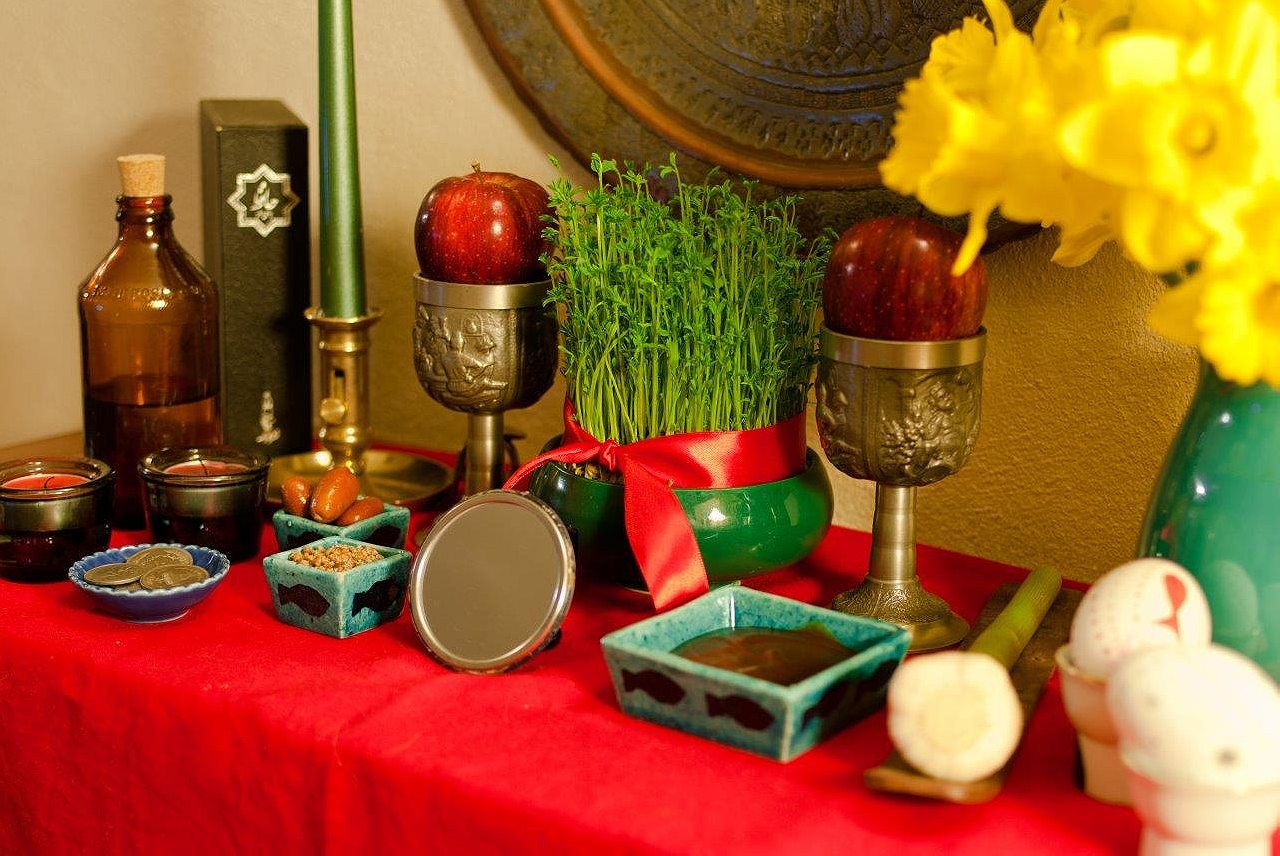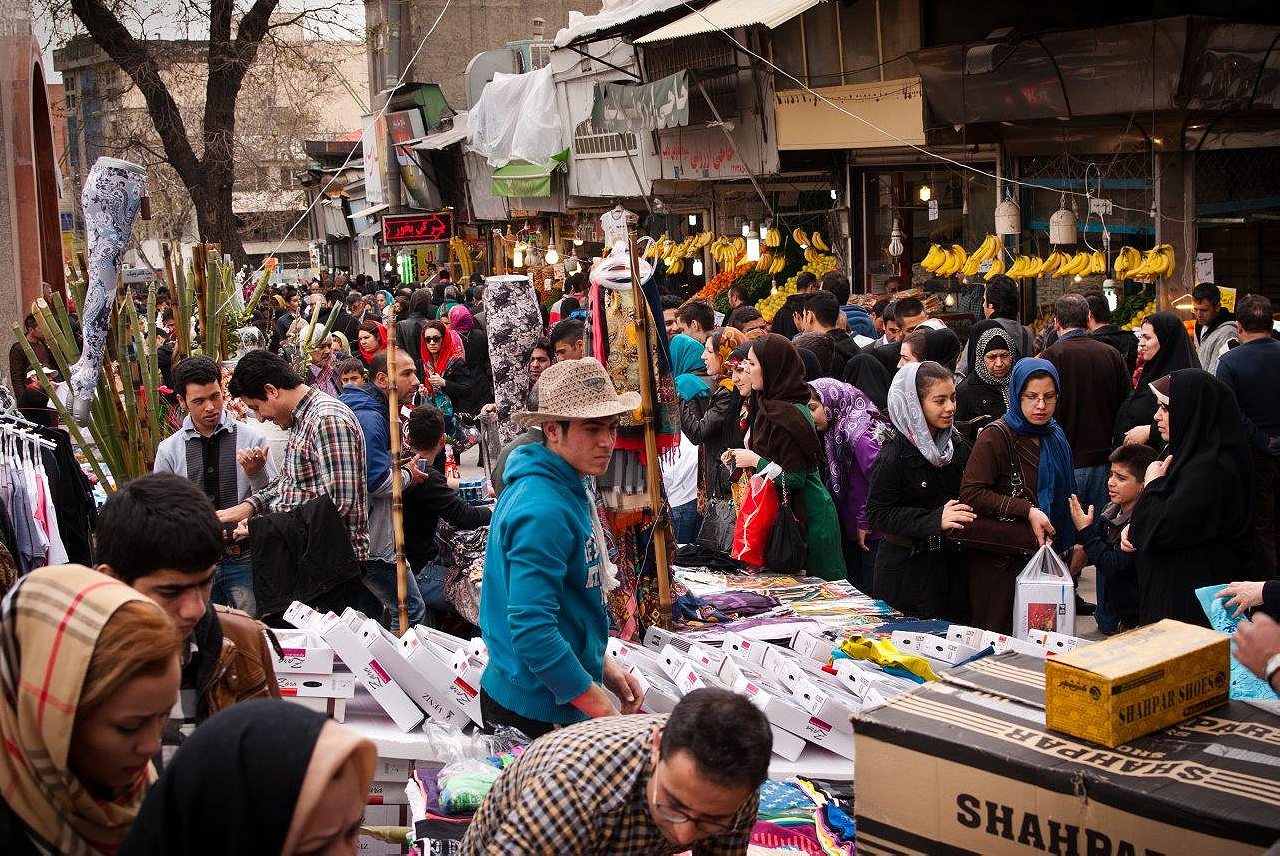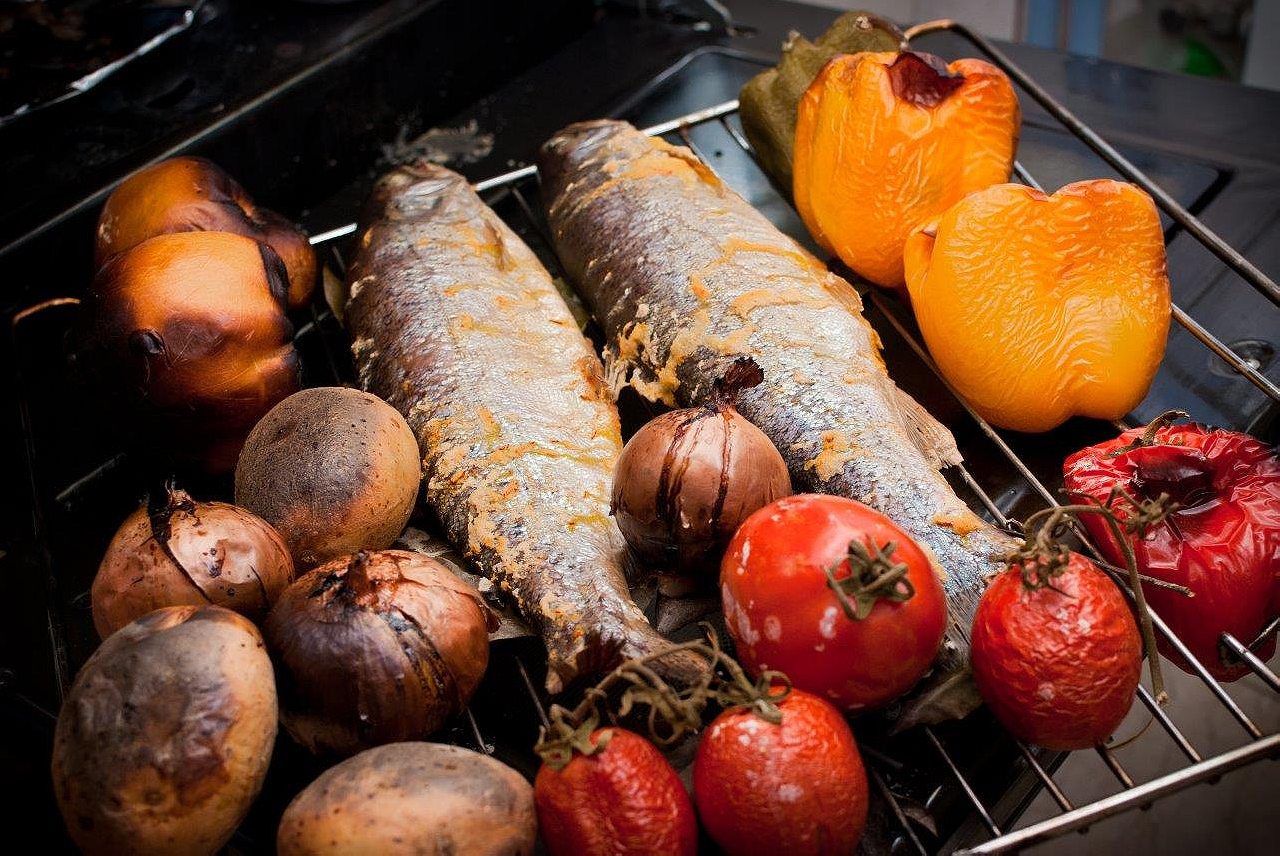The rituals of the spring equinox offer hope for new beginnings in troubled times.
In a corner of Maryam Eftekhari’s living room there sits an altar. On it, a small white candle burns, its flame gently flickering in front of a wrought silver mirror. Next to the candle, a pink hyacinth blooms, filling the room with the sweet scent of honeysuckle and ripe peaches. A dish of sprouting wheatgrass is tied together with a red ribbon. A goldfish darts around a glass bowl adjacent to a pile of shiny, red apples stacked in the shape of a pyramid. A single bulb of garlic sits in a crystal saucer surrounded by dainty dishes holding sumac and samanoo, a sweet, fudgy pudding made from germinated wheat.
Eftekhari’s carefully crafted altar has been assembled in her Tehran apartment for Nowruz, an ancient Zoroastrian festival that marks the beginning of the Persian calendar. The altar, called a sofreh-e haft seen in Farsi, is replicated in the homes of an estimated 190 million people around the world who celebrate the tradition in Iran and neighboring countries, including Afghanistan, Uzbekistan, and Turkmenistan.
Nowruz means ‘new day’ and takes place on the spring equinox, typically falling on March 20 or 21 in the Western calendar. It is a festival that has been celebrated in Iran for over 2,500 years and marks the end of winter and beginning of spring in the northern hemisphere. Its roots lie in Zoroastrianism, the ancient religion of Iran, whose practices are filled with rituals and symbolism associated with the five elements of earth, water, fire, air, and ether. Zoroastrianism is thought to have been one of the world’s first monotheistic religions, with many of its beliefs and practices deeply connected to nature. Today, 38 years after the Islamic revolution in Iran, Nowruz remains Iran’s most significant and celebrated annual festival, overshadowing the traditional Islamic festivals such as Eid e Fitr.
“Nowruz is our time to start afresh,” Eftekhari tells me as she fiddles with the arrangement of the altar, smoothing out the patterned tablecloth on which the artifacts sit. “The rituals, the sofreh ye haft-seen, and the food we eat all symbolize what we want to bring in for the year ahead. It focuses on new beginnings and always gives me hope.”

Hope can certainly seem in short supply in Iran these days, a country where growing social inequality and economic instability following decades of international sanctions have gravely impacted the lives of ordinary Iranians. Years of political isolation have gradually undermined the Iranian economy, eroding its once relatively affluent living standards and plunging many into poverty. The last five years in particular have seen soaring inflation rates affecting basic goods such as food and medicines, with everyday items such as fruits and vegetables doubling or tripling in price. Unemployment remains rife, especially among Iran’s youth, and while the lifting of the nuclear-related sanctions in 2016 bought a short-term boost to some areas of Iran’s economy, much of this has yet to trickle down to ordinary Iranians.
With an increasingly hostile rhetoric coming from the Trump administration and the recent ban on Iranian nationals entering the U.S., hope for a peaceful and more prosperous future is certainly high on the agenda for many Iranians this year, and the rituals of Nowruz provide an outlet through which people can express these feelings. Growing up, the rituals of Nowruz connected me to the holiday. I remember setting out on trips with my mum to the fields near our house, garden shears in hand, to collect hay for our pre-Nowruz bonfires. Or coming down the stairs in the morning to watch the affectionate care with which my mum would tend to her sprouting wheat seeds, gently wrapping them in damp tea towels and watering them lightly to grow the sprouting wheatgrass for our altar. Creating an auspicious sofreh ye haft-seen altar is one of the bedrocks of the Nowruz celebrations.
The objects placed on it will vary from house to house, but will be certain to display at least seven objects beginning with the letter ‘s’ in Farsi, each representing a particular quality or wish for the year ahead. Commonly, the haft-seen will include sprouting wheatgrass for rebirth and renewal, candles representing life and luck, painted eggs symbolizing fertility and creativity, a mirror reflecting the field of possibilities, apples and garlic for good health, vinegar for age and wisdom, gold coins for wealth and abundance, hyacinths for beauty, and a goldfish in a bowl, symbolizing life within life.
The collected works of Hafez, Iran’s most celebrated poet, whose poetry is considered to be of divine provenance, is also often to be found, or, alternatively, a copy of the Qur’an.
I am going to have to get physical with the men and women who are pushing me out of the way.
In the weeks before Nowruz, Iranians embark on a massive spring cleaning effort, de-cluttering their houses from top to bottom. Homes are subjected to what is known as khaneh tekani, which when literally translated means “shaking down the house.” Carpets are washed, walls are painted, and that cupboard at the back of the spare room which has accumulated all the junk from the last twelve months is finally emptied. The benefits of khaneh tekani aren’t limited to simple cleanliness. The spiritual impact of the ritual of de-cluttering has the power to generate fresh energy, clear mental and physical space, and release negative emotions. By clearing out the old, we can make way for the new.
Visiting the bustling Tajrish bazaar in the midst of the holiday preparations, I watch rows of street hawkers line the pavements with makeshift stalls, vendors animatedly shouting out their best deals for goods to place on the haft-seen altar. Attempting to buy some samanoo proved a somewhat perilous affair as dense crowds of Iranians congregated around my chosen stall, elbows pressing and pushing their fellow countrymen and women to one side, their arms already heavy with bags of nuts, sweets, and fruits for the stream of guests they will be welcoming to their homes in the weeks ahead. As they launch into loud haggling with the street sellers, I soon realize my polite British sensibilities aren’t going to serve me well if I want to buy anything before the new year ends. I am going to have to get physical with the men and women who are taking turns pushing me out of the way. Still, it takes me ten times as long as anyone else to buy the sweet wheat pudding.

Shopping aside, the streets of Tehran also provide a space for another important Nowruz ritual, char shambe soori, which takes place on the evening of the last Tuesday of the year. On this night, small bonfires are lit in public roads or private gardens, and friends and family gather to jump over the flames, enacting ancient adages to cleanse themselves of any misfortune from the year gone by and purify themselves for the year ahead. Fire ceremonies play an important role in many Zoroastrian rituals, and the specific mantra offered to the fire on char shambe soori asks the flames to take away any sickness of the mind or the body and to share instead its red glorious power, giving all who jump over it vitality and strength for the year ahead.
By the time the exact astronomical moment of the spring equinox has rolled around, house, home, body, and mind have been fully purified, leaving Iranians ready to gather in front of their haft-seen altars to mark the start of the year together. And as in most cultures, the first thing people do in honor of this celebration is to feast.
The food of Nowruz continues the emphasis on renewal and rebirth, with fresh herbs and spring greens incorporated into the main dishes to represent new life and new beginnings. The first meal of the year is always sabzi polo baa mahi, a fragrant mixed-herb pilaf speckled with finely chopped dill, coriander, chives, and parsley, and served with a simple white fried fish (the Iranian equivalent of turkey with all the trimmings). Smaller, herb-based dishes also find their way onto the table, such as kuku-ye sabzi, an aromatic, emerald-green herb frittata, or aash-e reshte, a robust and hearty herb, legume, and noodle soup topped with crispy fried onions, dried mint, and kashk, an umami-flavored fermented whey.
I visit the home of Nosrallah Saniee, a gregarious retired businessman who offers to show me his twist on the classic Nowruz meal: a whole, baked Caspian kutum—a large, firm, white fish from Northern Iran—marinated with lemon and saffron and served with dill and cumin rice. “Nowruz is the one time of year that all families gather to be with each other,” he says. “All the schools and offices in the country shut for two weeks so we can enjoy the holidays together.” As we chat, he prepares saffron the traditional Persian way, by grinding the red stamens with a pinch of granulated sugar in a pestle and mortar before leaving it to steep in hot water until it forms a potent scarlet elixir. “We always start the year with fish as it represents good luck,” he continues, rinsing his hands, which are now dyed orange from rubbing the saffron marinade all over the fish. “Unfortunately, though, not everyone in Iran can celebrate in this way. Sanctions have affected the country very badly. Some people have got much richer and some people much poorer. At Nowruz, some have so much that they throw food away at the end of their new year dinner, while some people some people will go to bed hungry.”

Conversations in Iran always lead back to politics, even when they start in the kitchen. As pharmacist Sima Mohamadzaadeh tells me as we sit chopping mounds of greens for a chicken, sour orange, and spinach stew, “In Iran, everyone is political. Just from the basic living situation here, you can’t not be. Politics for Iranians is like eating lunch, it’s like buying a loaf of bread, it’s just everyday life.” Time and again as I travel from home to home, from kitchen to kitchen, conversations inevitably come back to the economic hardships Iranians are facing. “In the last few years, our biggest concern has been the sanctions,” Mohamadzaadeh tells me, as she pushes the spinach in a large saucepan. “Sanctions have put people in Iran under huge economic pressure.”
Despite the social and economic hardships faced by many, the two-week national holiday that follows Nowruz is observed by most workers in Iran and the time is spent visiting family members and friends with boxes of cookies, cakes, and pastries to sweeten the start of everyone’s year. If you are lucky, you might be treated to a box of gaz, a soft, chewy, nougat flavored with pistachios and rosewater, or perhaps some light-as-air choux buns filled with thick slabs of cream known as naan e khamiee. More commonly, you will be greeted with shirini-eh khoshk: an assortment of nugget-sized biscuits made with chickpea flour or rice flour.
Thirteen days after Nowruz, sizdeh bedar marks the end of the festivities and the whole country embarks on a national picnic alongside a riverbank. Picnicking is a national pastime in Iran, but on sizdeh bedar the outdoor feasting is taken up a notch. It’s common to see families haul mini gas stoves to a nearby stream to warm up large pots of fluffy white Persian rice, eaten alongside juicy chicken kebabs or rich lamb stews infused with dried limes and saffron. Piles of freshly baked flatbreads are unveiled, ready to be filled with kukus (a type of Iranian frittata), tangy sheep’s cheese, thick slices of juicy tomatoes, and crunchy, small, sweet cucumbers. Fermented eggplant and cauliflower pickles; creamy, strained yogurt dips; and small bowls of olives complete the meal. The green platters of wheatgrass that everyone has been growing on their Nowruz altars during the previous weeks are brought along, and the final ritual in the celebration of new beginnings is to tie knots with the green shoots while making a wish. The wheatgrass is then thrown into running water, slowly merging back into the ecosystem, carrying everyone’s hopes and dreams for the year ahead.
The rituals of Nowruz may be ancient, but their longevity and the devotion with which they are still practiced in Iran is a testament to their power and continuing relevance. In an increasingly urban world, Nowruz offers an opportunity to re-connect with natural cycles. More than that, Nowruz celebrations are a chance to regroup, reset and re-energize for the year ahead. After a calamitous few months of global politics, with the shadow of uncertainty and a fear of the future cast over many in Iran and in the Iranian diaspora at large, the rituals also offer an opportunity to foster hope. Each year, Nowruz reminds us that no matter how dark, how cold or how unrelenting winter can be, spring always arrives.